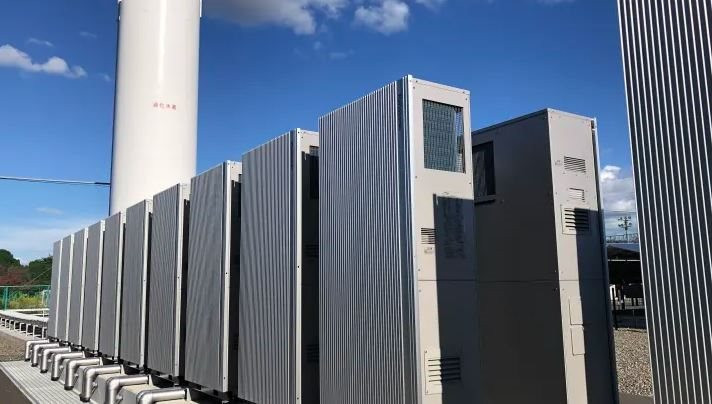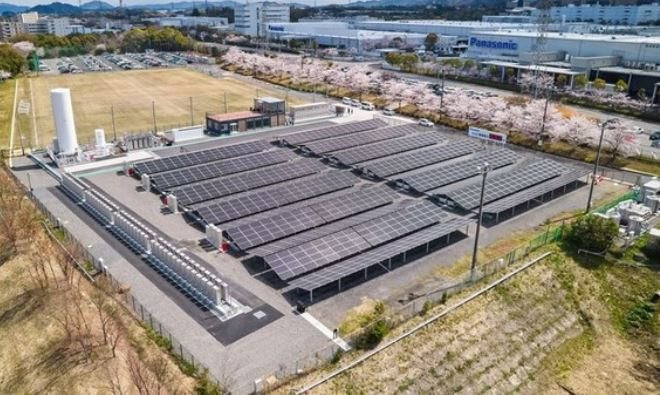Panasonic tests ‘factory of the future’ using 100% renewable energy
- Tram Ho
Beneath the high-speed bullet train soaring at 285 km/h, Norihiko Kawamura, manager of Panasonic’s Smart Energy Systems Business Unit, peered over Japan’s tallest 14-meter hydrogen tank. Not far away, a long array of solar panels, hydrogen fuel cells and Megapack storage batteries are considered the pride of Panasonic because the energy they generate is enough to run the Ene fuel cell factory. – Farm.
“ This is possibly the largest hydrogen consumer in Japan ,” Kawamura said. “ We estimate to use 120 tons of hydrogen per year. As Japan produces and imports more and more hydrogen in the future, this will be a suitable investment .”
It is known that Panasonic’s factory in Kusastsu, Shiga Prefecture, with an area of 52 hectares, was built in 1969 to produce household goods such as refrigerators, TVs and washing machines – things the Japanese are said to be very coveted when the country reconstructed after World War II.
Today, one corner of the plant is H2 Kibou Field, a sustainable energy facility that began operations in April. It houses a 78,000-litre hydrogen fuel tank, a 495 kilowatt hydrogen fuel cell array and 1.1 megawatts of lithium-ion battery storage. Panasonic also installed a large screen that displays the amount of electricity produced in real time from fuel cells and solar panels. It is known that about 80% of the energy generated comes from fuel cells, the rest is solar energy.
According to a Panasonic representative, this facility produces enough energy to service a fuel cell plant with a peak capacity of about 680 kW, while its annual usage is 2.7 gigawatts. Panasonic says this could be the template for the next generation of sustainable and new manufacturing.
“ This is the first production site to use 100% renewable energy ,” said Hiroshi Kinoshita of Panasonic’s Intelligent Energy Systems Business Unit. “ We want to expand it and work towards creating a decarbonized society .”

Panasonic tests ‘factory of the future’ using entirely renewable energy
An artificial intelligence-equipped energy management system (EMS) that automatically controls on-site power generation, converting between solar and hydrogen energy, reduces the amount of electricity purchased from the local grid. On hot summer days, if a fuel cell plant needs 600 kW, EMS may prefer 300 kW from solar, 200 kW from hydrogen fuel cells and 100 kW from storage batteries. . On cloudy days or low temperatures, this system will reduce kW from solar energy and increase kW from hydrogen and storage batteries.
“The important thing to make the production process greener and friendlier lies in an energy system that integrates renewable energy such as solar, wind, hydrogen energy, batteries… Panasonic has almost reached an ideal energy system. to do this ,” said Takamichi Ochi, senior manager for climate change and energy at Deloitte Tohmatsu Consulting.
However, H2 Kibou Field is not really 100% eco-friendly. It still has to depend on gray hydrogen, which is made from natural gas in a process that can release a lot of carbon dioxide.
Japan has traditionally relied on countries like Australia, which has a large source of renewable energy, to produce hydrogen. Local supplier Iwatani Corporatio, which previously partnered with Chevron to build 30 hydrogen fuel delivery sites in California by 2026, has also built a technology hub for green hydrogen production near Osaka.
However, there is an outstanding problem. Currently, the cost of powering a hydrogen fuel plant is much higher than that of a grid-tied plant. H2 Kibou Field expects the efforts of the Japanese government and industry to improve supply and distribution will be able to help reduce this cost significantly.

As the first site to use 100% renewable energy, the factory is expected to become a template for the next generation of sustainable production.
“ Our hope is that the cost of hydrogen will come down. Only then will we be able to achieve the same fee as the grid ,” Kawamura said.
Panasonic predicts that Japan’s 2050 carbon-neutral efforts will boost demand for new energy products. According to CNBC, the group’s fuel cell plant in Kusatsu has produced more than 200,000 Ene-Farm natural gas fuel cells for household applications. Commercialized in 2009, the plant extracts hydrogen from natural gas, generates energy by reacting with oxygen, and heats and stores hot water, with the ability to provide up to 500 watts of emergency power for eight hours. days in the event of a disaster.
“ Panasonic is one of the largest fuel cell manufacturers globally and has shipped around 250,000 units from the Kusatsu plant since 2009, ” said Shinsuke Morita, head of Panasonic’s fuel cell business at Panasonic. Europe said. “ We have the technology to absorb green hydrogen and produce electricity. This, coupled with Panasonic’s commitment to carbon neutrality in its operations by 2030, motivated us to choose to test zero-emission manufacturing in this region.”
Last year, the plant began selling pure hydrogen, hoping to gain access to the US and European markets, where the government has more measures to cut the cost of stored hydrogen than the country of the rising sun. It is known that in 2021, the US Department of Energy launched the Hydrogen Shot program to cut the cost of clean hydrogen by 80% to just 1 USD / kg within 10 years.
“ If we want to have 100% renewable energy by 2030, we have to start with something like that now, not in 2030 ,” Kawamura said.
By: CNBC, Business Green
Source : Genk
